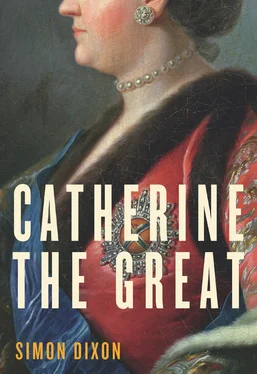‘Pleasant address’ seemed a distant enough prospect at Kazan where the cancellation of Canitz’s plays was a symptom of feuding between the governor and local nobles. Such tensions were only to be expected in a provincial society that had only recently begun to break away from patriarchal ways of life, in which the greater part of the nobility, living en famille on small estates in circumstances not much different from their own peasants, had been unaccustomed to socialising. 53Arguments among the Russian elite nevertheless helped to cast a more flattering light on the Tatars. The Orlovs were by no means the last Russians to be impressed by the simplicity of the Muslim service they witnessed at a mosque where the attentive humility of the worshippers contrasted sharply with the disrespectful behaviour of many Orthodox in church. 54Catherine herself watched with pleasure at a ball on 31 May as ‘the Mordvins, Chuvash, Cheremis, Votiaks and Tatars…all danced according to their custom to the sound of Tatar music and songs’. But it was impossible not to be unnerved by the kaleidoscopic variety she encountered in Kazan. In the course of the week she spent there, the empress saw the Tatar children at the seminary, finally received a delegation of recently baptised converts, greeted the son of the Kazakh khan and was presented to a party of Siberian merchants who had travelled almost 500 miles to petition her. 55Such experiences impressed upon her as never before the complexity of her multinational empire. Daunted by the challenge facing the Legislative Commission, she sat down to write her promised letter to Voltaire:
These laws about which people talk so much are, in the final analysis, not yet made. And who can answer for their benefits? In truth, it is posterity, and not us, who will have to decide that question. Imagine, I beg you, that they must serve for Asia as well as Europe, and what a difference in climate, peoples, customs, and even ideas! Here I am in Asia; I wanted to see it with my own eyes. There are twenty people of various kinds in this town, who in no way resemble one another. And yet we have to make a coat that will fit them all. It may well be possible to discover general principles, but the details? And what details! I might say that there is almost a whole world to be created, united, preserved. I may never finish it! 56
* * *
Although Catherine’s original intention had been to sail all the way to Astrakhan, the Geographical Description allowed for a shorter cruise ending further north, at Dmitrevsk. In the event, to speed her return to Moscow, the empress travelled only as far as Simbirsk, almost 700 miles downstream from Tver and ‘one hour eleven minutes and twenty seconds ahead of St Petersburg time’. 57Here she stayed on an estate belonging to Ivan Orlov. The beauty of the Volga lands was breathtaking. ‘These people are spoiled by God,’ she wrote to Panin, whose brother Peter owned an estate not far away. ‘Everything you can imagine is here in plenty and I do not know what else they could need: everything is available and everything is cheap.’ 58Having taken seven weeks to reach her destination, she raced back to Moscow in seven days, travelling by night and sleeping through the heat of the steppe, pausing only to change horses. Hundreds of subjects who lined the roadside to pay homage were passed by in a blur. When she reached the Golovin Palace at 7 p.m. on Thursday 14 June, she needed two days’ rest to recover from the journey. 59
Though the Court was immediately plunged into mourning—first for Prince Frederick of Prussia and then for Joseph II’s unhappy second wife, Josepha, who had fallen victim to smallpox in May—there was nothing gloomy about the empress’s mood. 60While Vasily Maikov celebrated her return with verses hymning the usefulness of her enlightened voyage, the deputies converged on Moscow in readiness for the opening of the Legislative Commission. Once Catherine had put the finishing touches to the protocols, she took the opportunity to relax. 61Although she had to review the cavalry on exercise in the Petrovsky woods and there were the usual festivities in honour of her accession day and Paul’s name day on 28 and 29 June, she preferred the less formal entertainments to be found on the various imperial estates dotted around the old capital. As soon as she returned from the Volga, she inspected her new apartments and stables at Kolomenskoye. ‘There is no need for any sort of rich decorations inside,’ she had insisted the previous December, after six months of close involvement with the plans. Though the project had been scheduled for completion by the Feast of St Peter at the end of June, she eventually moved in on 11 July, greeted at the gates by the local clergy in full fig. 62While waiting for Prince Makulov to finish the work, she found time to play on the new sledging pavilion at Pokrovskoye, to drive to the Sparrow Hills on the far side of the city, and to watch the fishing at Tsar Boris’s Ponds. 63She also inspected the stallions brought up from the provinces for the annual sale at the imperial stud farms at Khoroshevo and Pakhrino, where a huge quadrangular stable for 532 horses, under construction since 1752, had been completed in 1764. 64Perhaps she saw Gardi, a black stallion bred from Lombard stock in 1766, whose exceptionally luxuriant tail made him one of the most celebrated animals of the age. 65
Hunting was by far Catherine’s most frequent leisure activity. Between 18 June and 15 October, the court journal (by no means necessarily a complete record) registered some thirty-seven separate outings. The detailed breakdown—two grouse shoots, three hare chases and no fewer than thirty-two hawking expeditions—gives a good sense of her personal preferences, already reflected in institutional changes over the previous five years, which had seen the animal hunt cut back while the staff of the bird hunt rose from thirty-nine to forty-nine. As in St Petersburg, the preferred time for hawking was after lunch, at four or five in the afternoon, when Catherine liked to ride out in her carriage with her falconers alongside her to while away the journey. 66They also accompanied her as far as the palace at Bratovshchina on her pilgrimage to worship at the remains of St Sergii on his feast day, 5 August. For all her reservations about monasticism, the empress had always found at the Trinity lavra a scholarly atmosphere quite different from the obscurantism she encountered at the Fëdorov monastery, and it was a pleasure to return to the library she had so admired in 1762. 67
All this, however, was but a prelude to the ceremonial opening of the Legislative Commission on 30 July. Whereas her predecessors’ abortive commissions had been dry, bureaucratic affairs, hidden away in the chancelleries of St Petersburg, Catherine wanted hers to begin in a blaze of publicity. It was launched in the manner of a major Court occasion with a glittering carriage procession from the Golovin Palace to the Kremlin. The deputies assembled in the Monastery of Miracles before processing with the empress to a liturgy at the Dormition Cathedral at which those who belonged to other faiths remained outside. Afterwards, Catherine, wearing the small crown, stood before the throne in the audience hall of the old Kremlin palace (it does not survive today) with copies of her Instruction on the table beside her. In a notable departure from earlier Muscovite assemblies, only one clerical deputy had been elected. The ubiquitous Archbishop Dimitry, elected on behalf of the Synod, made a speech comparing the empress with Justinian. Replying on her behalf, the vice chancellor Prince Alexander Golitsyn (Alexander Stroganov’s friend from their student days in Geneva) stressed her hopes that the deputies would confer glory on themselves and their age by contributing to ‘the common good, the happiness of mankind, and the introduction of good manners and humanity, tranquillity, security and happiness to your dear fatherland’. Those who had already gathered in Moscow (some 460 out of the eventual total of 564) were permitted to kiss her hand. 68
Читать дальше












